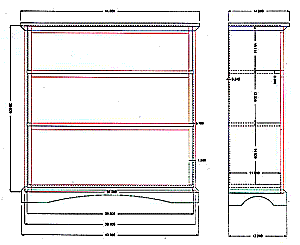
A few weeks ago, I got a message from a faithful reader about CAD(computer-aided design) programs. He wanted to know if we knew of any he could try out to see if it would be of any use to him. There were probably trial versions of CAD programs out on the Net, but I was too busy that day to go fishing for one. So I went over to associate editor Joanna Take’s desk and “borrowed” one of the two she had there. I mailed it off to Tommy Reep, the woodworker who contacted me, with the agreement that he would try out the software if he agreed to tell me how it worked for him.
Tommy was very diligent about sending me progress reports. I caught up with him a few days ago to find out how the CAD software worked for him. The program I sent him was called DesignCAD from Upperspace Technology and he wanted to try out a drawing program on his next project because, as he explained it, he was having some accuracy problems with his woodworking projects. “Everything I’d done so far had been in my head,” says Tommy.
So he wanted to try his hand at drawing up his next project, which was a TV stand for the new big screen TV he had purchased. It was currently sitting atop the old broken TV and he wanted a proper entertainment center for it, including some shelves for his wife’s collection of movies. But the best laid plans of woodworkers, even with a CAD program, gang aft agley (oft go astray for you non-Scott’s).
Somewhere along the way, his wife redirected the project and it became a bookshelf for her cookbooks. Though the drawing below doesn’t show it, glass doors were added to the final project.
Tommy spent about 2 weeks learning the ins and outs of the CAD program as he finished his design. There were, he admits, some very frustrating evenings working through the program with the reference manual and the software. But in the end, Tommy says, “it helped me tremendously.”
At first, he says, it was a little tricky getting used to the decimal measurements instead of fractions, but in the end it was a real boon. He was working with about 110 board feet of cherry his brother had cut up for him. It hadn’t been dried or stacked correctly, so he had to trim it down. It was cut 4/4 and by the time he had straightened the stock it was 11/16″ instead of ¾”. The decimals helped him keep the project more accurate with the oddly dimensioned stock. He said he never got more than 5 thousandths of an inch off on any part of the bookshelf.
This particular program runs about $129 and Tommy says it’s worth quite a bit more than that in his opinion. He’s going to keep working with it, because, as he puts it, “I haven’t accessed nearly all of the capabilities of this.”
– Bob Filipczak





